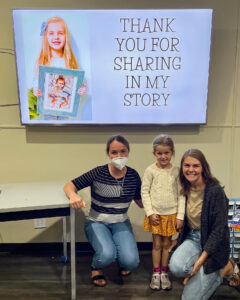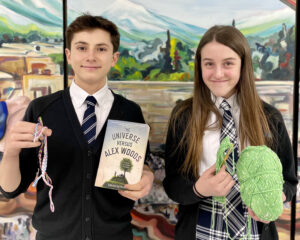As a humanities teacher of junior high students, it can be challenging to capture my students’ attention in a world of distractions. Many of them are hooked to their phones, preferring Tik Tok and Snapchat to reading novels and doing writing assignments.
This led me to reflect on what led me to my personal passion for the humanities in the first place. I remembered how the drama of the human experience captured my imagination. I remembered how stories of spiritual experiences, of fights for justice, of healing (individual and communal) filled me with a sense of humanity and purpose.
Through reading Amanda Achtman’s daily blog about death and dying at DyingToMeetYou.ca, and Dr. Kathryn Mannix’s book With the End in Mind: Dying, Death, and Wisdom in an Age of Denial, I became aware of how suffering, death, and grief actually bring us face-to-face with some of the most meaningful themes and experiences in human life.
Acknowledging that many families in my school community have endured considerable tragedies in recent years, my aim then became to incorporate the topic of death in the classroom in a sensitive yet significant way. Students tapped into their innate desire for relevance and meaning-making, and created projects that were tender and stirring.

Teacher Lesley Machon, left, with two of her Guest Speakers
The curriculum-twist this year involved an infusion of literature about grief, death, and healing. I also created several projects and assignments along these lines.
We began with a unit called “From Lab Coat to Sweatpants: Bridging the Gap Between Science and Empathy” where students read and researched medical stories and explored illness from both a scientific and emotional perspective. Then we explored different ways to talk about death through poetry, novel studies, and film studies. We invited guest speakers, including a mom and her daughter. The child was given 12-24 hours to live by doctors but received a rare transplant and was labeled a medical miracle. The students enjoyed this aspect immensely and asked insightful questions, such as what the mother felt when she was given the news of her daughter’s prognosis, and how she coped.
Students have been privileged to learn from various clergy/chaplains, a funeral director, and will soon enter into conversation with the respected palliative care physician and acclaimed author Dr. Mannix herself. I am very honoured that Dr. Mannix is willing to Zoom from the UK to junior high students here in Calgary to discuss ‘ordinary dying,’ and give the essential background information we all need for the realities of being human.
The students’ service project included the creation of bracelets, hats, and art for children in the Alberta Children’s Hospital. Seeing students’ creations bring joy to families at the hospital, and walking through the school hallways amidst posters they created as part of their medical research project, was incredibly moving.
In class, we read and analyzed poems such as “When Death Comes” by Mary Oliver, “When I Die” by Rumi, “When Great Trees Fall” by Maya Angelou, and “On Death” by Khalil Gibran. I chose the novel The Universe Versus Alex Woods for a Grade 9 novel study. During film studies, we watched Me, Earl and the Dying Girl; Up; and A Monster Calls.
The students responded so well to all of these speakers and materials. They began to display a greater maturity and to show a deeper sensitivity to others.

Two of Lesley Machon’s students
As a result of the impact I witnessed this exploration have on students, I published an article for a teaching magazine outlining our process with the hopes of inspiring other educators to incorporate this topic in their classroom and make death a less taboo topic.
The experience also motivated me to pursue additional training in Thanatology and grief and bereavement counseling to offer end-of-life support to fellow Albertans. This work has deepened my appreciation for life and transformed the way I show up in the classroom.
The class explored the possibility of meaningful human connection even in the midst of great loss and grief. Their studies and project cultured hope through acts of compassion, and enabled students to imagine a future where community containment and systemic support were intricately interwoven into experiences of hardship. By exploring the overlap between grief and love, they saw possibilities for meaning-making and connection, even in the face of death and loss. This was a profound tribute to hope.
Death is a subject that can be uncomfortable for many, but like many topics we find confronting grief, loss, and death are important for young people to explore. Doing so helps them appreciate life, engage with others in an empathetic and compassionate way, and postulate about living and dying with dignity and integrity.
What gives me hope about tackling these topics is the positive feedback I receive from my students, their parents, and members of the community. One of my students mentioned feeling more comfortable discussing the death of a loved one, and no longer felt the need to shy away from such a loss during conversations. A parent told me that their daughter now wants to pursue a career in pediatric transplant surgery after learning about how a transplant saved our guest speaker’s life. Other parents were pleased to hear how enthusiastically their children described the rituals and beliefs of different cultures and religions surrounding death. Community members thanked me for equipping our youth with the necessary knowledge and skills to handle such topics, and even asked for ways to incorporate the subject into their own dinner table discussions and the provincial curriculum.
These anecdotes give me the confidence that engaging difficult themes help students to see meaning in their education and to receive this education in a way that benefits them holistically. It is my hope that they will be better equipped to accompany loved ones who are approaching death and to know that death, rather than stealing away life, can also give us many lessons from which to grow and love.
Images courtesy of Lesley Machon








So many adults have not had the education that Lesley is offering her students, and it is so essential. The topics that we all need to dive into, as they apply to all of us, tend to be avoided leaving us surprised and unequipped when the inevitable happens.
Thank you Lesley for your courage to expose students to tender life skills that they, and all of us, need.